
Least squares¶
Faisal Qureshi
Professor
Faculty of Science
Ontario Tech University
Oshawa ON Canada
http://vclab.science.ontariotechu.ca
Copyright information¶
© Faisal Qureshi
License¶

This work is licensed under a Creative Commons Attribution-NonCommercial 4.0 International License.
import numpy as np
import matplotlib.pyplot as plt
import matplotlib.cm as cm
Lesson Plan¶
- Model fitting: Why?
- Linear regression
- Least squares
- 2D line fitting example
- Total least squares
- Aside: Singular Value Decomposition (SVD)
Why model fitting?¶
Finding objects/elements in an image¶


Image analysis and scene understanding¶


Least squares¶
2D line fitting example¶
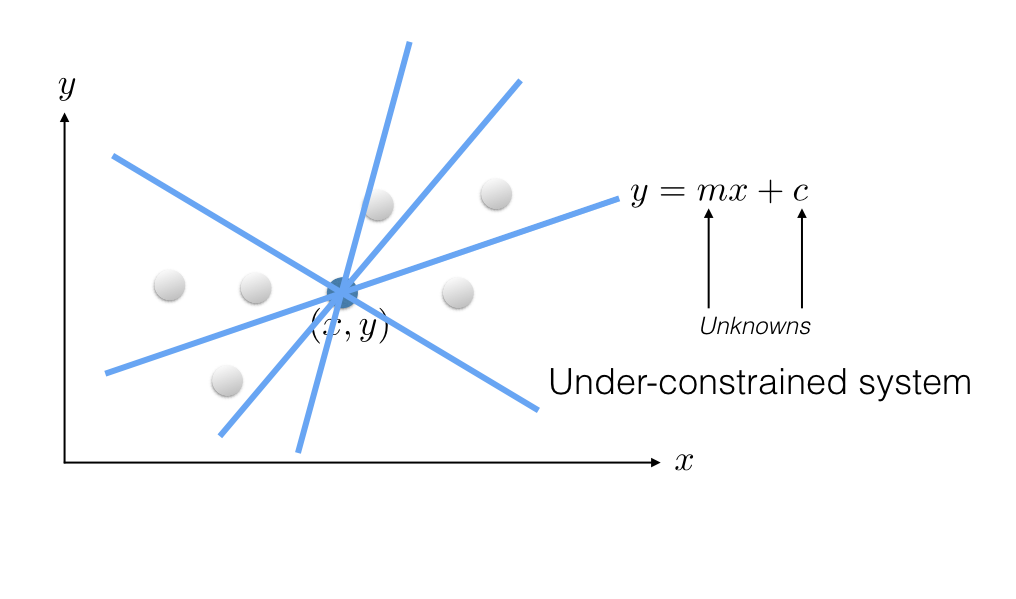
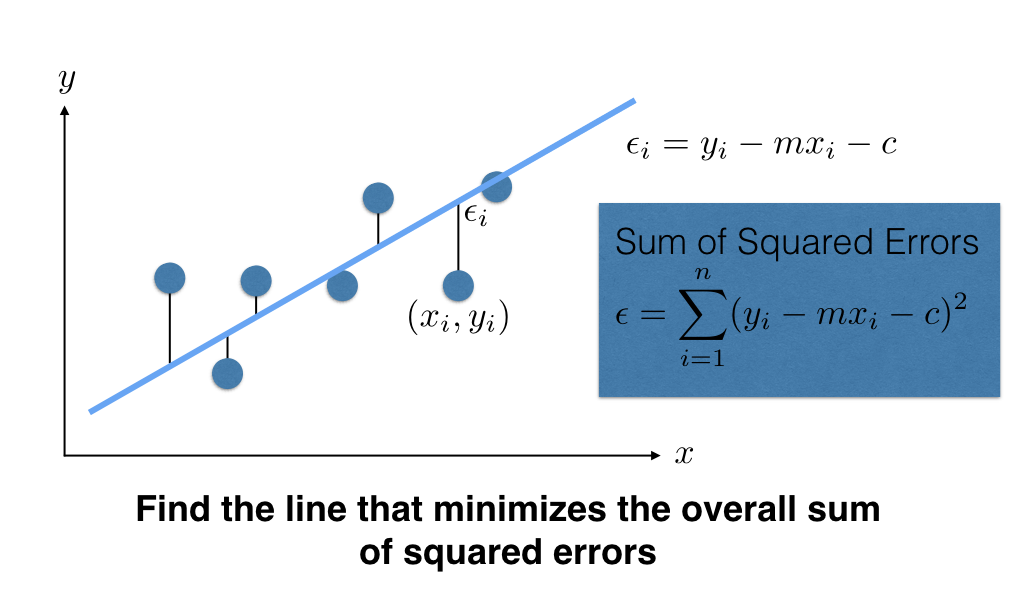
Sum of square differences is
$$ \epsilon = \sum_{i=1}^n (y_i - m x_i - c)^2 $$
We want to find values of slope $m$ and intercept $c$ so as to minimize the sum of squared differences $\epsilon$. Note that $\epsilon$ is a quadratic function (bowl shaped).
Quadratic function in 1D¶
$$ y = f(x) = (x + 4)^2 $$
plotting_x = np.linspace(-10,10,100)
quadratic_fn_1d = (plotting_x+4)**2
plt.figure(figsize=(5,5))
plt.title("Quadractic function in 1d")
plt.plot(plotting_x, quadratic_fn_1d)
plt.yticks([0])
plt.xticks([-4])
([<matplotlib.axis.XTick at 0x109209d30>], [Text(-4, 0, '−4')])
The derivation of $f(x)$ is $$ \frac{d y}{d x} = 2(x + 4) $$
By setting $$ \frac{d y}{d x} = 0 $$ we can find the value of $x$ that minimizes function $f(x)$. In this case it is $x=-4$.
deriv_quadratic_fn_1d = 2*(plotting_x + 4)
plt.figure(figsize=(5,5))
plt.title("Quadractic function in 1d")
plt.plot(plotting_x, quadratic_fn_1d, label='$f(x)$')
plt.plot(plotting_x, deriv_quadratic_fn_1d, label="$f'(x)$")
plt.legend()
plt.yticks([0])
plt.xticks([-4])
([<matplotlib.axis.XTick at 0x109243390>], [Text(-4, 0, '−4')])
Quadratic function in 2D¶
plotting_x = np.linspace(-2,2,11)
plotting_y = np.linspace(-2,2,11)
xx, yy = np.meshgrid(plotting_x, plotting_y)
quadratic_fn_2d = xx**2 + yy**2
from mpl_toolkits.mplot3d import Axes3D
fig = plt.figure(figsize=(14,6))
ax = fig.add_subplot(121, projection='3d')
ax.plot_surface(xx, yy, quadratic_fn_2d)
plt.xlabel('x')
plt.ylabel('y')
plt.xticks([])
plt.yticks([])
plt.subplot(122)
plt.imshow(quadratic_fn_2d, extent=[-2,2,-2,2])
plt.xlabel('x')
plt.ylabel('y')
plt.xticks([0.0])
plt.yticks([0.0])
plt.suptitle('2D quadratic function');
Solving for $m$ and $c$.¶
$$ \DeclareMathOperator*{\argmin}{arg\,min} m^*,c^* = \argmin_{m,c} \sum_{i=1}^n \left(y_i - m x_i - c \right)^2 $$
We can achieve this by setting $$ \frac{\partial \epsilon}{\partial m} = 0 $$ and $$ \frac{\partial \epsilon}{\partial c} = 0. $$
From calculus, we know that $$ \frac{\partial \epsilon}{\partial m} = - \sum_{i=1}^n 2 x_i \left(y_i - m x_i - c \right) $$ and $$ \frac{\partial \epsilon}{\partial c} = - \sum_{i=1}^n 2 \left(y_i - m x_i - c \right). $$
Setting these to 0, we get $$ \sum_{i=1}^n 2 x_i \left(y_i - m x_i - c \right) = 0 $$ and $$ \sum_{i=1}^n 2 \left(y_i - m x_i - c \right) = 0. $$
Let $$\langle y \rangle = \frac{1}{n} \sum_{i=1}^n y_i$$ and $$\langle x \rangle = \frac{1}{n} \sum_{i=1}^n x_i.$$
We can then re-write equation 2 above as $$ c = \langle y \rangle - m \langle x \rangle. $$
Re-write equation 1 above. $$ \begin{align} & \sum_{i=1}^n x_i y_i - m \sum_{i=1}^n x_i^2 - c \sum_{i=1}^n x_i = 0 \\ \Rightarrow & \frac{1}{n} \sum_{i=1}^n x_i y_i - \frac{m}{n} \sum_{i=1}^n x_i^2 - \frac{c}{n} \sum_{i=1}^n x_i = 0 \\ \Rightarrow & \langle x y \rangle - m \langle x^2 \rangle = c \langle x \rangle \end{align} $$ where $$ \langle x y \rangle = \frac{1}{n} \sum_{i=1}^n x_i y_i $$ and $$ \langle x^2 \rangle = \frac{1}{n} \sum_{i=1}^n x_i^2. $$
Substitute the value of $c$ $$ \begin{align} & \langle x y \rangle - m \langle x^2 \rangle = \langle x \rangle \langle y \rangle - m \langle x \rangle^2 \\ \Rightarrow & m \left( \langle x \rangle^2 - \langle x^2 \rangle \right) = \langle x \rangle \langle y \rangle - \langle x y \rangle \\ \Rightarrow & m = \frac{\langle x \rangle \langle y \rangle - \langle x y \rangle}{\langle x \rangle^2 - \langle x^2 \rangle} \end{align} $$
Use this value of $m$ to solve for $c$.
2D line fitting example 1¶
# Generate some data
np.random.seed(0)
m_true = .75
c_true = 1
x = np.hstack([np.linspace(3, 5, 5), np.linspace(7, 8, 5)])
y = m_true * x + c_true + np.random.rand(len(x))
data = np.vstack([x, y]).T
n = data.shape[0]
plt.figure(figsize=(7,7))
plt.scatter(data[:,0], data[:,1], c='red', alpha=0.9)
plt.xlim([0,10])
plt.ylim([0,10])
plt.title('Generating some points from a line');
x = data[:,0]
y = data[:,1]
print(f'x =\n{x.reshape(n,1)}')
print(f'y =\n{y.reshape(n,1)}')
x = [[3. ] [3.5 ] [4. ] [4.5 ] [5. ] [7. ] [7.25] [7.5 ] [7.75] [8. ]] y = [[3.7988135 ] [4.34018937] [4.60276338] [4.91988318] [5.1736548 ] [6.89589411] [6.87508721] [7.516773 ] [7.77616276] [7.38344152]]
mean_x = np.mean(x)
mean_y = np.mean(y)
mean_x2 = np.mean(np.square(x))
mean_xy = np.mean(x * y)
print(f'<x> = {mean_x}')
print(f'<y> = {mean_y}')
print(f'<x2> = {mean_x2}')
print(f'<xy> = {mean_xy}')
<x> = 5.75 <y> = 5.928266283314543 <x2> = 36.4375 <xy> = 36.68301372420285
m = (mean_x * mean_y - mean_xy) / (mean_x**2 - mean_x2)
print(f'm = {m}')
m = 0.7690318800427336
c = mean_y - mean_x * m
print(f'c = {c}')
c = 1.506332973068825
x_plotting = np.linspace(0,10,100)
y_plotting = m * x_plotting + c
plt.figure(figsize=(7,7))
plt.scatter(data[:,0], data[:,1], c='red', alpha=0.9)
plt.plot(x_plotting, y_plotting, 'b-')
plt.xlim([0,10])
plt.ylim([0,10])
plt.title('Line fitted to data using least squares.')
Text(0.5, 1.0, 'Line fitted to data using least squares.')
2D line fitting - vector notation¶
$$ \begin{align} \epsilon &= \sum_{i=1}^n (y_i - m x_i - c)^2 \\ &= \| \left[ \begin{array}{c} y_1 \\ y_2 \\ \vdots \\ y_n \end{array} \right] - \left[ \begin{array}{cc} x_1 & 1\\ x_2 & 1\\ \vdots & \vdots \\ x_n & 1 \end{array} \right] \left[ \begin{array}{c} m\\ c \end{array} \right] \|^2 \\ &= \| \mathbf{y} - \mathbf{A} \mathbf{p} \|^2 \\ &= \mathbf{y}^T\mathbf{y} - 2 ( \mathbf{A} \mathbf{p} )^T \mathbf{y} + (\mathbf{A} \mathbf{p})^T \mathbf{A} \mathbf{p} \end{align} $$
We know that $$ \frac{\partial \epsilon}{\partial \mathbf{p}} = -2 \mathbf{A}^T \mathbf{y} + 2 \mathbf{A}^T \mathbf{A} \mathbf{p} $$
Setting $$ \frac{\partial \epsilon}{\partial \mathbf{p}}=0. $$ we get $$ \begin{align} & -2 \mathbf{A}^T \mathbf{y} + 2 \mathbf{A}^T \mathbf{A} \mathbf{p} = 0 \\ \Rightarrow & \mathbf{A}^T\mathbf{A} \mathbf{p} = \mathbf{A}^T \mathbf{y} \\ \Rightarrow & \mathbf{p} = (\mathbf{A}^T\mathbf{A})^{-1} \mathbf{A}^T \mathbf{y} \end{align} $$
$(\mathbf{A}^T\mathbf{A})^{-1}$ is called the psuedo inverse $\mathbf{A}$.
2D line fitting - intuition - linear algebra¶

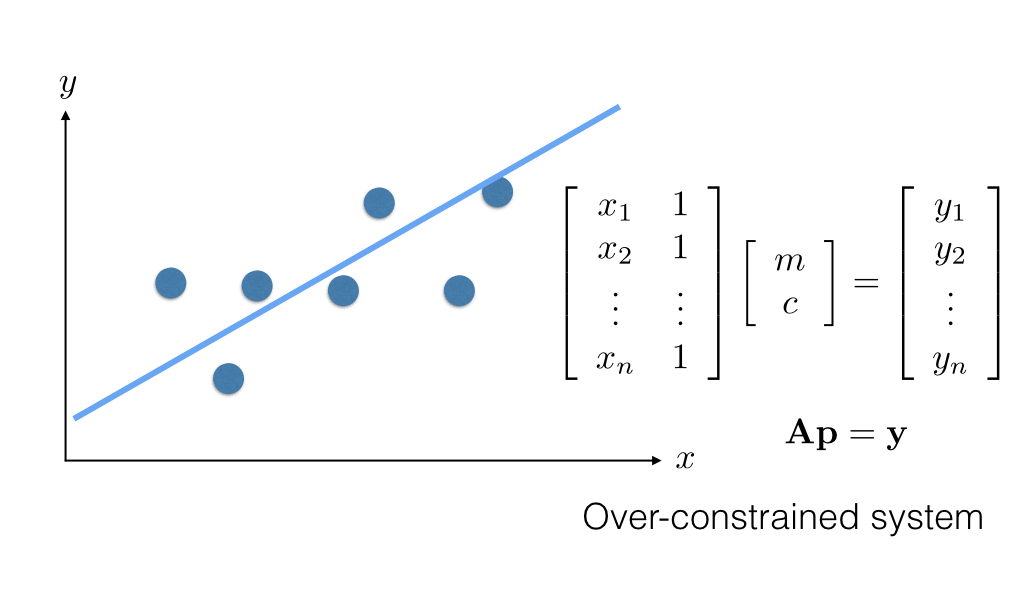
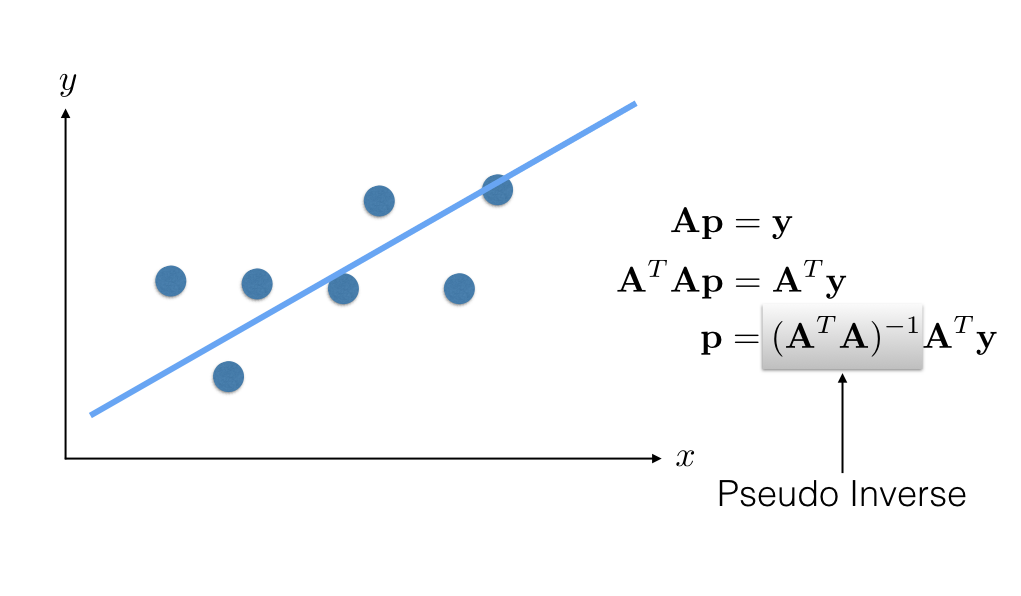
2D line fitting example 2¶
# Generate some data
np.random.seed(0)
m_true = .75
c_true = 1
x = np.hstack([np.linspace(3, 5, 5), np.linspace(7, 8, 5)])
y = m_true * x + c_true + np.random.rand(len(x))
#x = np.linspace(1,9,10)
#y = np.ones(10)+5
#y = np.linspace(1,9,10)
#x = np.ones(10)+5
data = np.vstack([x, y]).T
n = data.shape[0]
plt.figure(figsize=(7,7))
plt.scatter(data[:,0], data[:,1], c='red', alpha=0.9)
plt.xlim([0,10])
plt.ylim([0,10])
plt.title('Generating some points from a line')
Text(0.5, 1.0, 'Generating some points from a line')
print(f'data =\n{data}')
n = data.shape[0]
print(f'Number of data items = {n}')
data = [[3. 3.7988135 ] [3.5 4.34018937] [4. 4.60276338] [4.5 4.91988318] [5. 5.1736548 ] [7. 6.89589411] [7.25 6.87508721] [7.5 7.516773 ] [7.75 7.77616276] [8. 7.38344152]] Number of data items = 10
A = np.ones([n, 2])
A[:,0] = data[:,0]
print(f'A =\n{A}')
A = [[3. 1. ] [3.5 1. ] [4. 1. ] [4.5 1. ] [5. 1. ] [7. 1. ] [7.25 1. ] [7.5 1. ] [7.75 1. ] [8. 1. ]]
AtA = np.dot(A.T,A)
print(f'AtA =\n {AtA}')
AtA = [[364.375 57.5 ] [ 57.5 10. ]]
AtY = np.dot(A.T, data[:,1].reshape(n,1))
print(f'AtY = \n{AtY}')
AtY = [[366.83013724] [ 59.28266283]]
# m = slope
# c = intercept
m_and_c = np.dot(np.linalg.inv(AtA), AtY)
m = m_and_c[0]
c = m_and_c[1]
print(f'm = {m}')
print(f'c = {c}')
m = [0.76903188] c = [1.50633297]
x_plotting = np.linspace(0,10,100)
y_plotting = m * x_plotting + c
plt.figure(figsize=(7,7))
plt.scatter(data[:,0], data[:,1], c='red', alpha=0.9)
plt.plot(x_plotting, y_plotting, 'b-')
plt.xlim([0,10])
plt.ylim([0,10])
plt.title('Line fitted to data using least squares.');
Total least squares¶
2D line fitting example¶
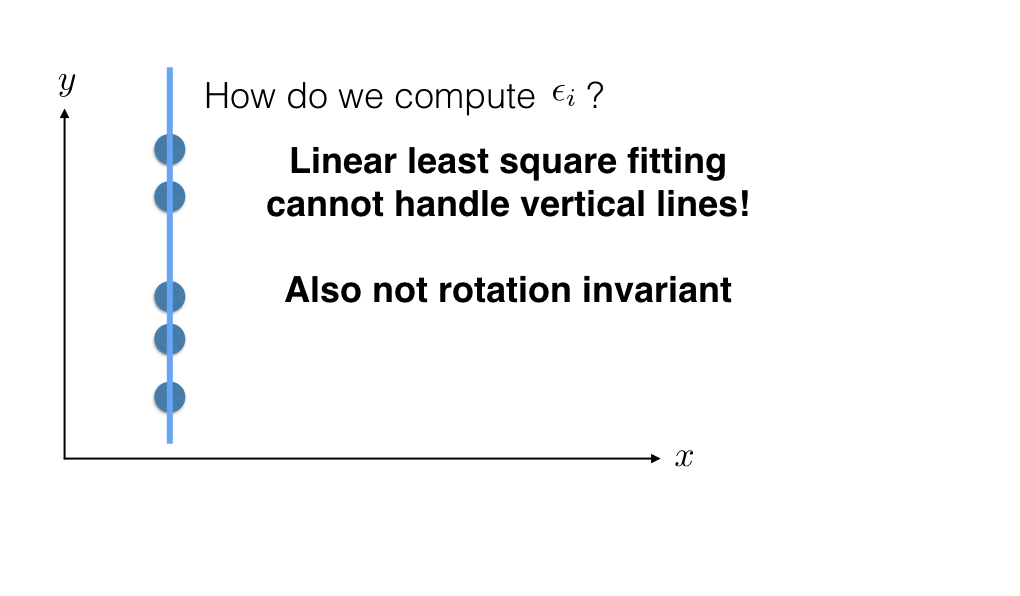

Solving for $a$, $b$, and $c$¶
Minimize $$ \epsilon = \sum_{i=1}^n (a x_i + b y_i + c)^2\mathrm{\ s.t.\ } (a,b)^T(a,b) = 1 $$
From calculus $$ \frac{\partial \epsilon}{\partial c} = 2 \sum_{i=1}^n (a x_i + b y_i + c). $$ Setting $$ \frac{\partial \epsilon}{\partial c} = 0, $$ we get $$ \begin{align} & \sum_{i=1}^n (a x_i + b y_i + c) = 0 \\ \Rightarrow & a \sum_{i=1}^n x_i + b \sum_{i=1}^n y_i + n c = 0 \\ \Rightarrow & c = - \frac{a \sum_{i=1}^n x_i}{n} - \frac{b \sum_{i=1}^n y_i}{n}\\ \Rightarrow & c = - a \langle x \rangle - b \langle y \rangle \end{align} $$
Substituting $c$ back in $\epsilon$ $$ \begin{align} \epsilon &= \sum_{i=1}^n \left[a x_i + b y_i + \left(- a \langle x \rangle - b \langle y \rangle\right)\right]^2 \\ &= \sum_{i=1}^n \left[ a \left( x_i - \langle x \rangle \right) + b \left( y_i - \langle y \rangle \right) \right]^2 \\ &= \| \left[ \begin{array}{cc} x_1 - \langle x \rangle & y_1 - \langle y \rangle \\ x_2 - \langle x \rangle & y_2 - \langle y \rangle \\ \vdots & \vdots \\ x_n - \langle x \rangle & y_n - \langle y \rangle \\ \end{array} \right] \left[ \begin{array}{c} a \\ b \end{array} \right] \|^2 \\ &= \| \mathbf{A} \mathbf{p} \|^2 \end{align} $$
Note that this is not the same $\mathbf{A}$ as the one that we constructed for linear least squares.
We can thus re-write our problem as $$ \DeclareMathOperator*{\argmin}{arg\,min} \mathbf{p}^* = \argmin_\mathbf{p} \| \mathbf{A} \mathbf{p} \|^2 \mathrm{\ s.t.\ }\mathbf{p}^T\mathbf{p} = 1. $$
Solution is the eigenvector corresponding to the smallest eigenvalues of $\mathbf{A}^T\mathbf{A}$.2D line fitting example 3¶
# Generate some data
np.random.seed(0)
m_true = .75
c_true = 1
# x = np.hstack([np.linspace(3, 5, 5), np.linspace(7, 8, 5)])
# y = m_true * x + c_true + np.random.rand(len(x))\
#x = np.linspace(1,9,10)
#y = np.ones(10)+5
y = np.linspace(1,9,10)
x = np.ones(10)+1
data = np.vstack([x, y]).T
n = data.shape[0]
plt.figure(figsize=(7,7))
plt.scatter(data[:,0], data[:,1], c='red', alpha=0.9)
plt.xlim([0,10])
plt.ylim([0,10])
plt.title('Generating some points from a line')
Text(0.5, 1.0, 'Generating some points from a line')
print(np.vstack((x,y)))
[[2. 2. 2. 2. 2. 2. 2. 2. 2. 2. ] [1. 1.88888889 2.77777778 3.66666667 4.55555556 5.44444444 6.33333333 7.22222222 8.11111111 9. ]]
print(f'x =\n {data[:,0].reshape(n,1)}')
x = [[2.] [2.] [2.] [2.] [2.] [2.] [2.] [2.] [2.] [2.]]
mean_x = np.mean(data[:,0])
print(f'mean_x = {mean_x}')
mean_x = 2.0
print(f'y =\n {data[:,1].reshape(n,1)}')
y = [[1. ] [1.88888889] [2.77777778] [3.66666667] [4.55555556] [5.44444444] [6.33333333] [7.22222222] [8.11111111] [9. ]]
mean_y = np.mean(data[:,1])
print(f'mean_x = {mean_y}')
mean_x = 5.0
A = np.hstack([(x-mean_x).reshape(n,1), (y-mean_y).reshape(n,1)])
print(f'A =\n{A}')
A = [[ 0. -4. ] [ 0. -3.11111111] [ 0. -2.22222222] [ 0. -1.33333333] [ 0. -0.44444444] [ 0. 0.44444444] [ 0. 1.33333333] [ 0. 2.22222222] [ 0. 3.11111111] [ 0. 4. ]]
AtA = np.dot(A.T, A)
print(f'AtA =\n{AtA}')
AtA = [[ 0. 0. ] [ 0. 65.18518519]]
e, v = np.linalg.eig(AtA)
print(f'eigenvalues = \n{e}')
print(f'eigenvectors = \n{v}')
eigenvalues = [ 0. 65.18518519] eigenvectors = [[1. 0.] [0. 1.]]
smallest_eigen_value_index = np.argmin(e)
print(f'Index for smallest eigenvalue = {smallest_eigen_value_index}')
Index for smallest eigenvalue = 0
p = v[:, smallest_eigen_value_index]
print(f'Eigenvector corresponding to the smallest eigenvector =\n{p}')
Eigenvector corresponding to the smallest eigenvector = [1. 0.]
a = p[0]
b = p[1]
c = - a * mean_x - b * mean_y
print(f'a = {a}, b={b}, and c={c}')
print(f'Equation of the line is: x={-c/a}')
a = 1.0, b=0.0, and c=-2.0 Equation of the line is: x=2.0
plotting_x = np.linspace(0, 10, 100)
plotting_y = np.linspace(0, 10, 100)
xx, yy = np.meshgrid(plotting_x, plotting_y)
z = a * xx + b * yy + c
fig = plt.figure(figsize=(7,7))
plt.imshow(z, origin='lower', extent=(0,10,0,10))
plt.colorbar()
plt.contour(xx, yy, z, [0])
plt.scatter(data[:,0], data[:,1], c='red', alpha=0.9)
plt.xlim([0,10])
plt.ylim([0,10])
plt.title('Line fitted using total least squares')
Text(0.5, 1.0, 'Line fitted using total least squares')
A = np.vstack((x,y,np.ones(len(x)))).T
print(A)
AtA = np.dot(A.T,A)
print(AtA)
e, v = np.linalg.eig(AtA)
print(f'eigenvalues = \n{e}')
print(f'eigenvectors = \n{v}')
smallest_eigen_value_index = np.argmin(e)
print(f'Index for smallest eigenvalue = {smallest_eigen_value_index}')
p = v[:, smallest_eigen_value_index]
print(f'Eigenvector corresponding to the smallest eigenvector =\n{p}')
a, b, c = p[0], p[1], p[2]
print(f'a = {a}, b={b}, and c={c}')
plotting_x = np.linspace(0, 10, 100)
plotting_y = np.linspace(0, 10, 100)
xx, yy = np.meshgrid(plotting_x, plotting_y)
z = a * xx + b * yy + c
fig = plt.figure(figsize=(7,7))
plt.imshow(z, origin='lower', extent=(0,10,0,10))
plt.colorbar()
plt.contour(xx, yy, z, [0])
plt.scatter(data[:,0], data[:,1], c='red', alpha=0.9)
plt.xlim([0,10])
plt.ylim([0,10])
plt.title('Line fitted using total least squares')
print(f'Equation of the line is: x={-c/a}')
[[2. 1. 1. ] [2. 1.88888889 1. ] [2. 2.77777778 1. ] [2. 3.66666667 1. ] [2. 4.55555556 1. ] [2. 5.44444444 1. ] [2. 6.33333333 1. ] [2. 7.22222222 1. ] [2. 8.11111111 1. ] [2. 9. 1. ]] [[ 40. 100. 20. ] [100. 315.18518519 50. ] [ 20. 50. 10. ]] eigenvalues = [ 3.56030753e+02 9.15443183e+00 -3.00994406e-15] eigenvectors = [[-3.06923496e-01 -8.40117829e-01 -4.47213595e-01] [-9.39280288e-01 3.43150901e-01 3.42758055e-16] [-1.53461748e-01 -4.20058915e-01 8.94427191e-01]] Index for smallest eigenvalue = 2 Eigenvector corresponding to the smallest eigenvector = [-4.47213595e-01 3.42758055e-16 8.94427191e-01] a = -0.44721359549995876, b=3.4275805455575054e-16, and c=0.8944271909999155
Equation of the line is: x=1.9999999999999956
Aside: Singular Value Decomposition (SVD)¶
SVD of a matrix $\mathbf{A} \in \mathbb{R}^{m \times n}$ is defined as $$ \mathbf{A} = \mathbf{U} \mathbf{D} \mathbf{V}^T $$ such that $\mathbf{U}$ is an $m \times n$ matrix with orthognal columns, $\mathbf{D}$ is an $n \times n$ diagonal matrix containing singular values, and $\mathbf{V}$ is an $n \times n$ orthognal matrix.
The column of $\mathbf{V}$ corresponding to the smallest singular value in $\mathbf{D}$ is the smallest eigenvector of $\mathbf{A}^T \mathbf{A}$.
